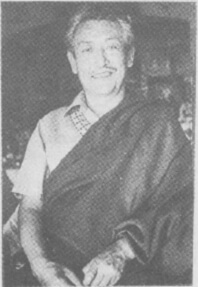| The following article is from the Summer, 1997 issue of the Snow Lion Newsletter and is for historical reference only. You can see this in context of the original newsletter here. |
LAMA KUNGA RINPOCHE
at Ewam Choden Meditation Center
California
by Pamela Cantrell
Published in Summer Newsletter 1997:
Q: Rinpoche, would you please tell the readers a little about Ewam Choden?
A: This is a Tibetan Buddhist Meditation Center. Tibetan monasteries are strictly for Buddhist monks. Ewam Choden is not a monastery, it is a Buddhist learning center. All kinds of people can stay here. It is small and students have always lived here to study. It was started in 1971 and then established as a non-profit educational organization to study and preserve Tibetan culture. In 1973, we were able to purchase this house for the center in Kensington.
Q: Do you bestow empowerments and teachings at Ewam Choden?
A: Yes, I live here to teach basic Buddhism. I bestow empowerments and give teachings. We also hold Sunday meditations from 10 to 11 AM. We have a public meditation program consisting of various on-going activities. If anyone is interested, they can contact us for information.
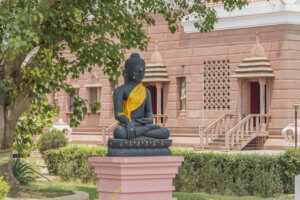
Q: I have heard that the Sakya lamas are more reluctant to give out the secret teachings. Is this true?
A: I'm not sure whether that is true or not; maybe Sakya lamas are more strict about giving teachings. If there are students, they give teachings. It is important that the proper students are given the proper teachings. If there are some good quality students, then maybe they will be given more important teachings. Lam Dre teachings, for example, are not readily available to the public, but students with good qualities, good knowledge of Vajrayana Buddhism, and devotion to the lama, their karma ripens and those students receive more teachings.
to enjoy it is a signal that it is beneficial to the mind
Q: What do you expect from your students?
A: I don't expect too much from the students, but that they feel comfortable with my spiritual gift. I would like them to receive the teachings as if they were given food to share with me. If they don't enjoy it that's OK, but to enjoy it is a signal that it is beneficial to the mind. If the teachings bring joy to the student, I as a lama am more happy!
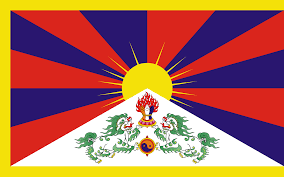
A: I am into my sixties now. People my age were born in Tibet and raised there. Our children have not been born in Tibet. We have a good memory of Tibetan culture and Tibetan religious customs. We remember the systems. We are elderly people now.
The Dalai Lama is the head of our culture. He is both a secular and a spiritual teacher.
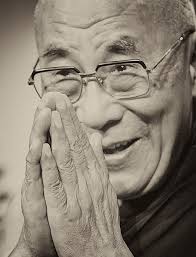
A: I am worried about carrying on my responsibility, about carrying on a small cultural preservation. We refugees outside are trying to do the best that we can do individually. This is very important, I think. The Dalai Lama is the head of our culture. He is both a secular and a spiritual teacher. He is also in his sixties and he is aging too. He is working very hard for the sake of all Tibetans.
Q: Is there anything specifically that you still want to accomplish in this lifetime, Rinpoche?
A: Yes, I would like to see my center as an ongoing entity whether I am living here in this world or not. Also, I still have my dream about establishing a Maitreya Buddha Temple - a place where Buddhists of all nationalities can gather and pray. It would especially be a place where Tibetan students can come. In Tibet a traditional Maitreya Buddha temple is very famous and has been throughout the centuries. Maitreya Buddha is the future Buddha. As Buddhist we try to evoke the future Buddha to come before everything gets worse. So there will be enlightenment sooner for the benefit of sentient beings, that's my wish.
It would be of Tibetan architecture in a style that people really enjoy seeing. It would be the first in the Bay Area and would add to the minority cultural climate here in the Bay Area.
Maitreya Buddha is the future Buddha. As Buddhist we try to evoke the future Buddha to come before everything gets worse. So there will be enlightenment sooner for the benefit of sentient beings, that's my wish.
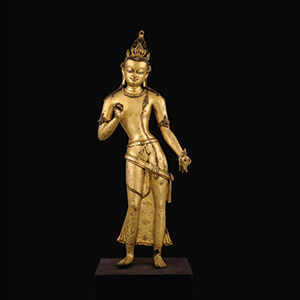
In Buddhist tradition, Maitreya is the future Buddha of this world.
Q: Rinpoche, is there anything specifically that the readers interested in Maitreya or those interested in Buddhism or Tibetan culture can do to help you succeed with this temple project?
A: I send a welcome to all friends and students to participate in the project of building a Maitreya Buddha Temple and learning center. They can help monetarily, physically, anything that you can contribute. I have been saving money for many years, but much more is required to see this project manifest.
Q: Rinpoche, how can Tibetan Buddhists overcome resistance to change?
A: To change is very important; change from bad to good is a very excellent human thing to do. We have to learn to live harmoniously and live together. The mind which students have is the raw material from which one can build beautiful things, like enlightenment. To do this for the benefit of all sentient beings means that you become a supremely precious, priceless being who can help future sentient beings and that is the goal.
Understand that ego is not necessarily bad. You have to maintain some kind of positive ego in order to gain enlightenment.
Q: What role does the ego play in our resistance to change?
A: Understand that ego is not necessarily bad. You have to maintain some kind of positive ego in order to gain enlightenment. Ego is that basic foundation, that raw material and without ego you cannot become established. You have to recognize that the intrinsic nature of the ego is just mere awareness, and light, and that the ultimate nature of that ego is ego-less; there is nothingness. So when you try to grasp at ego, there is nothing to grasp.
Q: In your father's book concerning his imprisonment in China, In the Presence of My Enemies, he just stated facts, he made no judgement, he was just clear and precise about his experience. Was it surprising to you that he was able to be this way?
A: Equanimity is a main practice of Buddhism. Although he was a layman, my dad was also a religious person. When the country was in turmoil and his own situation was terrible, he ended up in prison for twenty years. He knew no one in the world could help and that he had to help himself. He had to apply all of his spiritual understanding to the situation. His spiritual understanding was the only thing he had that was of use in his struggle to survive.
Luckily he survived twenty years of harsh imprisonment. Then, after all that spiritual practice, all he could do is just state the truth. He did not have to exaggerate the pain, it is something everybody knows. He did not have to tell what happened to Tibet because everybody in the world knows basically the trauma and loss of civilization. All he could do was present his experience.
I was also in the same situation. I remember that in the late 1950's we were really scared about the loss of family. But if you get too emotional or too angry it will not help because it's only going to deteriorate your own mind. It is of no use. Our duty is to tell the truth and just experience what happens. We ask for help to do that, this is our purpose.
Equanimity is a main practice of Buddhism... He had to apply all of his spiritual understanding to the situation. His spiritual understanding was the only thing he had that was of use in his struggle to survive.
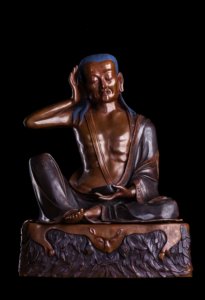
མི་ལ་རས་པ། Milarepa
Q: You translated Milarepa's work in the books Miraculous Journey and Drinking from the Mountain Stream. As a reincarnation of a student of Milarepa, what do you think that Milarepa has to teach the Western Buddhist student?
A: Milarepa was a true Buddhist. Milarepa had a long history of family problems. He was born in a wealthy family. When his father died he got into a lot of trouble with his relatives and had a very difficult life at an early age. Then, he turned around and went back to spiritual life. Spiritual life was the most important thing for him and through it he was able to help many sentient beings.
All human beings, east or west, have family problems, community problems, country problems. In the world of samsara, it is all problems that is the truth of samsara. Milarepa turned from that and found the truth of suffering and the truth of the path which the Buddha showed. The truth of human suffering is still true today. I think the teachings of Milarepa carry a message for the benefit of modern society.
Q: Thank you, Rinpoche.
For more information about the programs at Ewam Choden Tibetan Buddhist Center, click here.
The truth of human suffering is still true today. I think the teachings of Milarepa carry a message for the benefit of modern society.
Related Articles:


